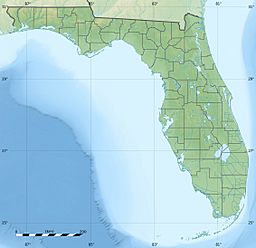Lake Tulane facts for kids
Quick facts for kids Lake Tulane |
|
|---|---|
| Location | Highlands County, Florida |
| Coordinates | 27°35′10″N 81°30′13″W / 27.586084°N 81.503495°W |
| Type | lake |
| Surface area | 88 ares (95,000 sq ft) |
| Max. depth | 70 feet (21 m) |
Lake Tulane is a natural lake in Highlands County, Florida. It's one of many lakes in the area formed in a special way. The lake is shaped like an oval. It covers about 88 acres and is up to 70 feet deep. Homes surround Lake Tulane in Avon Park, Florida.
Contents
Discovering Lake Tulane
How Lake Tulane Formed
Lake Tulane is a type of lake called a sinkhole lake. Sinkholes happen when underground rock, like limestone, dissolves away. This creates empty spaces or caves below the surface.
Over time, the ground above these spaces can collapse. When this happens, a depression forms, which can then fill with water to create a lake. Lake Tulane formed this way.
The lake sits on the Lake Wales Ridge. This is a higher area made of loose sand. Beneath the sand are layers of clay and other rocks. Water slowly dissolved the limestone deep below, causing the ground to sink and form Lake Tulane.
Clues from the Lakebed: Ancient Climate
The mud and dirt at the bottom of Lake Tulane are very special. They hold amazing clues about Earth's ancient climate. Scientists can study these layers to learn about past weather and plants.
Scientists have taken long samples, called "cores," from the lakebed. These cores are like time capsules. They show what the climate was like over 60,000 years ago! This is one of the oldest climate records in eastern North America.
By looking at tiny bits of pollen in these cores, scientists learned about the plants that grew around the lake long ago. They found periods when pine trees were common. Other times, oak trees and ragweed were more common.
These changes in plants matched big climate events that happened in the oceans. This shows how connected the land and sea climates are. When pine trees were common, it meant there was more rain. The Gulf of Mexico was also warmer then.
When oak and ragweed were common, the climate was drier. The Gulf of Mexico and the North Atlantic Ocean were colder. This was because of melting glaciers.
Fun at Lake Tulane
Lake Tulane is a popular spot for outdoor activities. People enjoy swimming, boating, and fishing here.
There is a public boat ramp on the west side of the lake. This makes it easy for people to launch their boats. On the south side, there is a public swimming beach. It's a great place to cool off on a hot day. Many people say the fishing at Lake Tulane is excellent!


